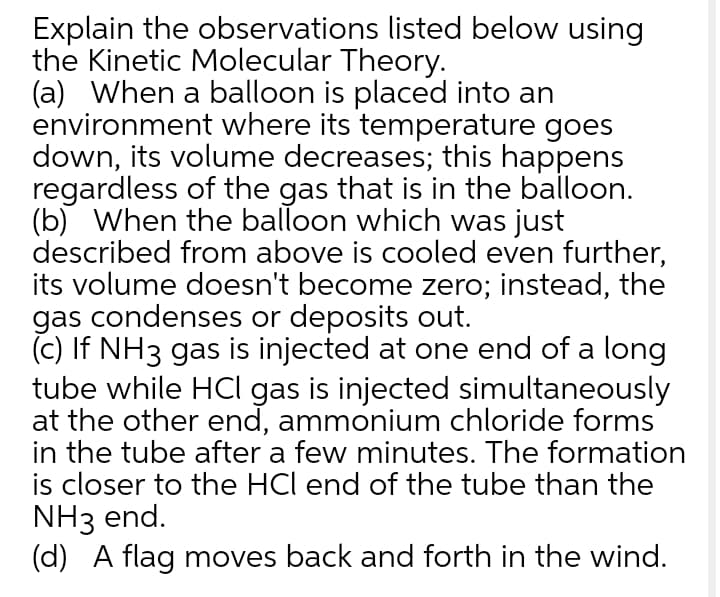Explain the observations listed below using the Kinetic Molecular Theory. (a) When a balloon is placed into an environment where its temperature goes down, its volume decreases; this happens regardless of the gas that is in the balloon. (b) When the balloon which was just described from above is cooled even further, its volume doesn't become zero; instead, the gas condenses or deposits out. (c) If NH3 gas is injected at one end of a long tube while HCI gas is injected simultaneously at the other end, ammonium chloride forms in the tube after a few minutes. The formation is closer to the HCl end of the tube than the NH3 end. (d) A flag moves back and forth in the wind.
Explain the observations listed below using the Kinetic Molecular Theory. (a) When a balloon is placed into an environment where its temperature goes down, its volume decreases; this happens regardless of the gas that is in the balloon. (b) When the balloon which was just described from above is cooled even further, its volume doesn't become zero; instead, the gas condenses or deposits out. (c) If NH3 gas is injected at one end of a long tube while HCI gas is injected simultaneously at the other end, ammonium chloride forms in the tube after a few minutes. The formation is closer to the HCl end of the tube than the NH3 end. (d) A flag moves back and forth in the wind.
Chemistry: Principles and Reactions
8th Edition
ISBN:9781305079373
Author:William L. Masterton, Cecile N. Hurley
Publisher:William L. Masterton, Cecile N. Hurley
Chapter5: Gases
Section: Chapter Questions
Problem 78QAP
Related questions
Question

Transcribed Image Text:Explain the observations listed below using
the Kinetic Molecular Theory.
(a) When a balloon is placed into an
environment where its temperature goes
down, its volume decreases; this happens
regardless of the gas that is in the balloon.
(b) When the balloon which was just
described from above is cooled even further,
its volume doesn't become zero; instead, the
gas condenses or deposits out.
(c) If NH3 gas is injected at one end of a long
tube while HCI gas is injected simultaneously
at the other end, ammonium chloride forms
in the tube after a few minutes. The formation
is closer to the HCl end of the tube than the
NH3 end.
(d) A flag moves back and forth in the wind.
Expert Solution
This question has been solved!
Explore an expertly crafted, step-by-step solution for a thorough understanding of key concepts.
This is a popular solution!
Trending now
This is a popular solution!
Step by step
Solved in 3 steps

Knowledge Booster
Learn more about
Need a deep-dive on the concept behind this application? Look no further. Learn more about this topic, chemistry and related others by exploring similar questions and additional content below.Recommended textbooks for you

Chemistry: Principles and Reactions
Chemistry
ISBN:
9781305079373
Author:
William L. Masterton, Cecile N. Hurley
Publisher:
Cengage Learning


Chemistry
Chemistry
ISBN:
9781305957404
Author:
Steven S. Zumdahl, Susan A. Zumdahl, Donald J. DeCoste
Publisher:
Cengage Learning

Chemistry: Principles and Reactions
Chemistry
ISBN:
9781305079373
Author:
William L. Masterton, Cecile N. Hurley
Publisher:
Cengage Learning


Chemistry
Chemistry
ISBN:
9781305957404
Author:
Steven S. Zumdahl, Susan A. Zumdahl, Donald J. DeCoste
Publisher:
Cengage Learning

Chemistry: An Atoms First Approach
Chemistry
ISBN:
9781305079243
Author:
Steven S. Zumdahl, Susan A. Zumdahl
Publisher:
Cengage Learning

General Chemistry - Standalone book (MindTap Cour…
Chemistry
ISBN:
9781305580343
Author:
Steven D. Gammon, Ebbing, Darrell Ebbing, Steven D., Darrell; Gammon, Darrell Ebbing; Steven D. Gammon, Darrell D.; Gammon, Ebbing; Steven D. Gammon; Darrell
Publisher:
Cengage Learning

Introductory Chemistry: A Foundation
Chemistry
ISBN:
9781285199030
Author:
Steven S. Zumdahl, Donald J. DeCoste
Publisher:
Cengage Learning